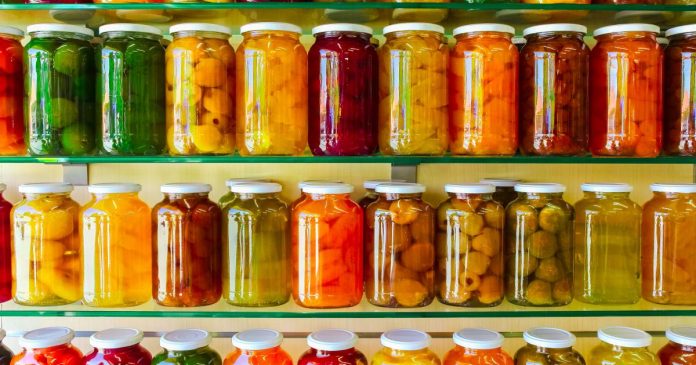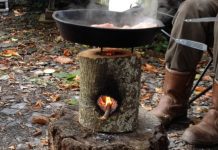Canning, Preserving and Storing the Harvest
When we consider canning, preserving and storing the harvest, keeping food safe for later is the goal. Whether we are preparing for a gathering, an event, or preparedness, food is a necessary item. Preparing for what MAY come and not knowing how or what that could entail, adds another facet to the preparing. How long will we need to store it? Can we estimate how much will we need to store? What it the best method to keep it fresh? All of these questions need to be addressed, in order to successfully prepare for food in an uncertain, what if, situation.
Why Store Food
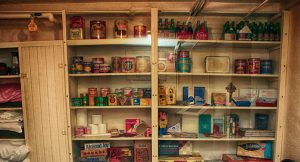

On the one hand, this may seem like a ridiculous question. We all need to eat. And we need to eat every day in order to stay strong and healthy and do our work. It may seem unnecessary to store food in any quantity if there is a local grocery store on every corner. But what if a prolonged emergency situation develops? Stores run out of food quickly, and if roads are closed or destroyed then deliveries will not be made. So, having a weeks worth of food stored at home can give you peace of mind. Some people will choose to have even more food on hand. Canning, preserving and storing food will give you garden fresh foods to enjoy, all year long.
Canning, Preserving, and Storing the Harvest – Different Ways to Store Food
The most common ways to store fresh food for the future are canning, dehydrating, and freezing.
Canning refers to both preserving food with a pressure canner and with a hot water bath canner. When the foods are fruits, and other high acid foods such as pickles, the hot water bath canner are appropriate. This method normally takes less time. The food will be safe to eat for at least one year, according to USDA guidelines.
Pressure canning must be used for non-acidic vegetables such as green beans, corn, beets, and vegetable mixtures. In addition, meats and complete meals can be preserved using a pressure canner.
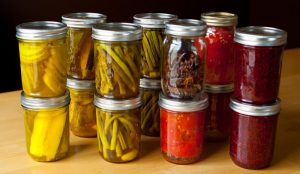

Canning requires some equipment. Pressure canners will be the largest cost expenditure, with hot water bath canners being considerably less expensive but not as versatile. Glass jars, commonly referred to as mason jars or Ball jars are used to store the food. The jars can be reused, in canning, but it is often recommended that a new lid be used each time you can in the jar, to prevent a bad seal. (edit 2019- recent canning lid manufacturers have produced new lids that can be used more than one time, in some circumstances. Read labels carefully).
Related: How Do You Know if a Canning Recipe is Safe
Dehydrating Food- An excellent skill when canning, preserving and storing the harvest.
Dehydrating requires low, dry heat over a longer time to slowly draw the moisture out of the food. Food that is dehydrated has an unlimited shelf life if it is done properly. Meat, fruits, and vegetables can all be dehydrated. After the food is dehydrated, the food should be stored in an airtight container.
To dehydrate food, you can use a commercial dehydrator like the one made by Excalibur or the one made by Nesco. It is also possible to use a screen, the sun, and dry air to dehydrate food. Herbs can be hung in bunches in a dry spot with good air circulation. The oven can also be used, in an extremely low heat setting.
Freezing Food
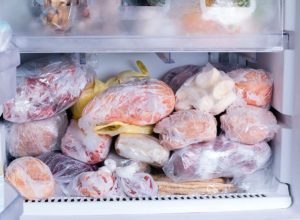

The third method for storing food is freezing. Freezing requires that the food is protected by appropriate wrapping material to keep air from reaching the food. Air, along with subfreezing temperatures can lead to a process called freezer burn. Freezer burned food is not attractive, may not cook correctly and has lost taste and nutrients. Another concern with using strictly freezing as the method of food preservation is that if the power fails, your food must be cooked or eaten. Finding out that a freezer full of food has thawed is a very rude awakening. Take steps to prevent this from happening.
We check our freezer daily, ensuring that it is working properly and that the door is closed tightly. Why do we do this? Because we have learned from experience when our freezer door was left open once, resulting in food thawing and spoiling. Another time, a hurricane and a subsequent power outage for over a week led to our freezer thawing. We had to give the contents of our freezer to our friends, who still had power so that our food would not spoil.
Related: How To Tell If Your Frozen Food Has Gone Bad
How do I Prepare With Stored Food?
My plan of action now is to utilize all three methods of food preservation. I can some items, freeze some and dehydrate others. This way, I have the convenience of frozen food, which is less time consuming to store, the freshness of canned foods, and the dehydrated foods with the long shelf life. I particularly prefer to dehydrate squash over freezing. Using it in recipes is just as easy. Herbs are another item I choose to dehydrate.
Everyone will make the decision that works best for them. If you don’t have a large freezer, just choose one or two foods to store in the freezer. We do not live in a remote, off-grid, area, yet I have lost count of the number of times our power has been out for extended time periods of days or weeks. I learned early, that having the right foods for our family, and various ways to prepare food, allowed us to stay in our home and whether the circumstances.
Storing Dry Foods
One last note on food preservation. When storing items like pasta, flour, rice, grains, sugar etc, be sure to use bug proof, airtight containers. How disappointing would it be to go to your stored food, thinking that you are all prepared, only to find that the bag of flour has been chewed into by mice and now has a family of insects living inside? Even when using airtight storage containers, make a point of checking your stores regularly to ensure they are remaining pest free.



